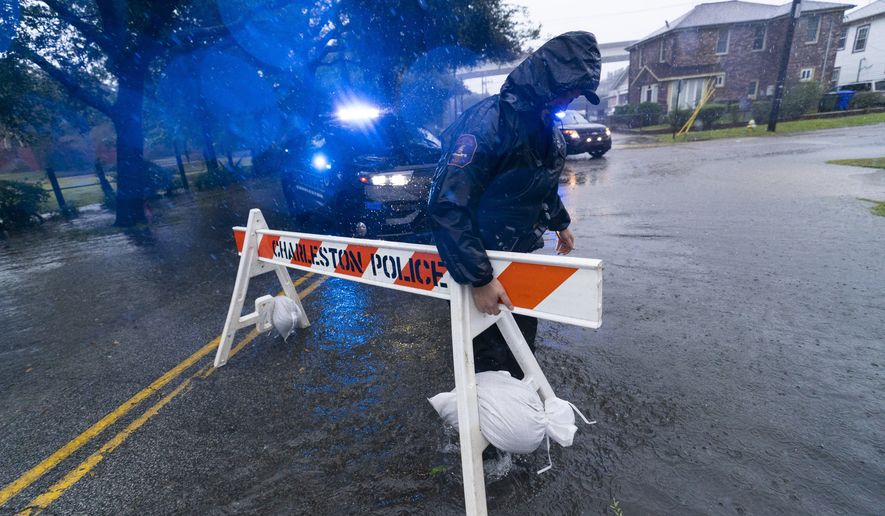CHARLESTON, S.C. — A revived Hurricane Ian threatened coastal South Carolina and the historic city of Charleston with severe flooding Friday after the deadly storm caused catastrophic damage in Florida and trapped thousands in their homes.
Sheets of rain whipped trees and power lines and left many areas on Charleston’s downtown peninsula under water by midday. A popular pier in the beach community of Pawleys Island collapsed and floated away. Ian’s anticipated landfall was expected to coincide with high tide, which would make flooding worse.
Ian left a broad swath of destruction after it came ashore on Florida’s Gulf Coast as one of the strongest storms ever to hit the U.S. The storm flooded areas on both of Florida’s coasts, tore homes from their slabs, demolished beachfront businesses and left more than 2 million people without power. At least nine people were confirmed dead in the U.S. — a number that was almost certain to increase as officials confirm more deaths and search for people.
With winds holding at 85 mph (140 kph), the National Hurricane Center’s update at 11 a.m. Friday placed Ian about 60 miles (95 km) southeast of Charleston.
The center’s hurricane warning stretched from the Savannah River to Cape Fear. The forecast predicted a storm surge of up to 7 feet (2.1 meters) into some Carolina coastal areas, and rainfall of up to 8 inches (20 centimeters).
In Florida, rescue crews piloted boats and waded through riverine streets Thursday to save thousands of people trapped amid flooded homes and buildings shattered by Hurricane Ian.
Florida Gov. Ron DeSantis said Friday that rescue crews had gone door-to-door to over 3,000 homes in the hardest-hit areas.
“There’s really been a Herculean effort,” he said during a news conference in Tallahassee.
Climate change added at least 10% more rain to Hurricane Ian, according to a study prepared immediately after the storm, said its co-author, Lawrence Berkeley National Lab climate scientist Michael Wehner.
Among those killed were an 80-year-old woman and a 94-year-old man who relied on oxygen machines that stopped working amid power outages, as well as a 67-year-old man who was waiting to be rescued died after falling into rising water inside his home, authorities said.
Officials fear the death toll could rise substantially, given the wide territory swamped by the storm.
Florida Division of Emergency Management Director Kevin Guthrie said responders have focused so far on “hasty” searches, aimed at emergency rescues and initial assessments, which will be followed by two additional waves of searches. Initial responders who come across possible remains are leaving them without confirming, he said Friday, describing as an example the case of a submerged home.
“The water was up over the rooftop, right, but we had a Coast Guard rescue swimmer swim down into it and he could identify that it appeared to be human remains. We do not know exactly how many,” Guthrie said.
At least three people were reported killed in Cuba after the hurricane struck there on Tuesday.
In Florida, businesses near Fort Myers Beach were completely razed, leaving twisted debris. Broken docks floated at odd angles beside damaged boats. Fires smoldered on lots where houses once stood.
“I don’t know how anyone could have survived in there,” William Goodison said amid the wreckage of a mobile home park where he’d lived for 11 years. Goodison rode out the storm at his son’s house inland.
The hurricane tore through the park of about 60 homes, leaving many destroyed or mangled beyond repair, including Goodison’s. Wading through waist-deep water, Goodison and his son wheeled two trash cans containing what little he could salvage — a portable air conditioner, some tools and a baseball bat.
The road into Fort Myers Beach was littered with broken trees, boat trailers and other debris. Cars were abandoned in the road, having stalled when the storm surge flooded their engines.
Emergency crews sawed through toppled trees to reach stranded people. Many in the hardest-hit areas were unable to call for help because of electrical and cellular outages.
A chunk of the Sanibel Causeway fell into the sea, cutting off access to the barrier island where 6,300 people live.
Hours after weakening to a tropical storm while crossing the Florida peninsula, Ian regained strength Thursday evening over the Atlantic. The National Hurricane Center predicted it would hit South Carolina as a Category 1 hurricane Friday, still much weaker than the Category 4 hurricane it was on Wednesday.
National Guard troops were being positioned in South Carolina to help with the aftermath, including any water rescues. And in Washington, President Joe Biden approved an emergency declaration for the state, a needed step to speed federal assist for recovery once Ian passes.
In North Carolina, Gov. Roy Cooper urged residents to prepare for torrents of rain, high winds and potential power outages.
•: Gomez Licon reported from Punta Gorda, Florida; Associated Press contributors include Terry Spencer and Tim Reynolds in Fort Myers, Florida; Cody Jackson in Tampa, Florida; Freida Frisaro in Miami; Mike Schneider in Orlando, Florida; Seth Borenstein in Washington; and Bobby Caina Calvan in New York.




Please read our comment policy before commenting.